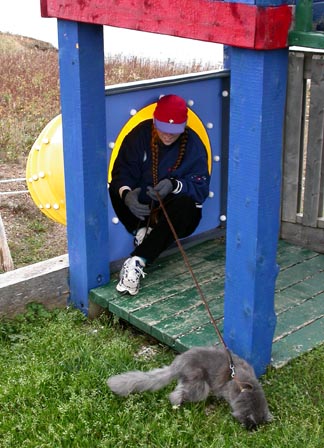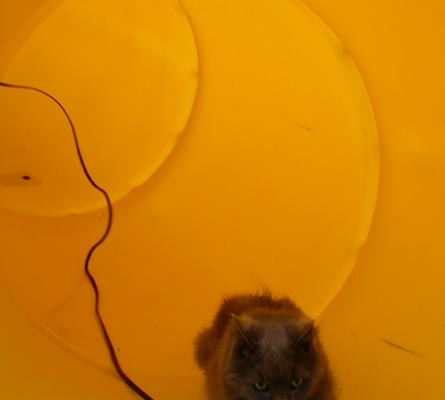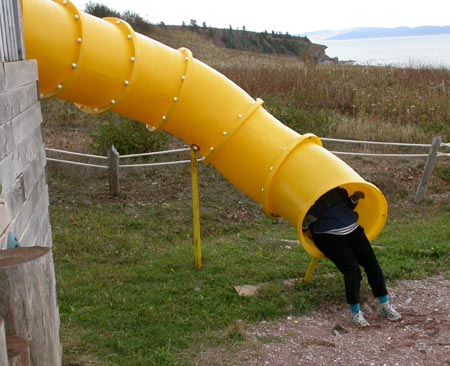In 1497, Giovanni Caboto, known to most of us as John Cabot, landed in Bonavista, Newfoundland. Of course, it wasn’t Bonavista then. And back then, they didn’t have bikes, let alone The Big Bike.
We arrived in town at the same time as a yellow school bus, loaded with passengers from a small cruise ship. “The mayor has come out to greet you,” announced their amplified tour guide. “Here’s Mayor Betty.”
Each cruise ship tourist shook hands with the mayor, an attractive blonde lady in a red blouse with an elaborate gold chain around her neck. “That’s my chain of office,” she told the folks as she shook their hands and handed them a Bonavista lapel pin.
Barry and Dad and I attached ourselves to the end of the cruise ship line. That way, we got to shake Betty’s hand, too. I got a great picture of her with my Dad, who told her he’d met a lot of mayors, but none as attractive. My Dad’s a flirt, like me.
After dinner that evening, we drove back to town because we’d seen something unusual there: A bicycle with seats for 30 people. Known as “The Big Bike,” it’s used as a fundraiser for the Canadian Heart and Stroke Foundation. In exchange for fundraising, local groups were entitled to a 15-minute ride. This I had to see.
The bike has a footprint about the size of a big bus, with ten rows of three seats on a red metal frame. The front left seat has a steering wheel and, most importantly, a brake. In the rear is a fancy, high seat, without pedals, used for dignitaries. All the other seats are normal black bicycle seats, each with non-steering handlebars and a set of pedals.
When we arrived, there were lots of people milling about The Bike. We were on the fringes, taking pictures, when along came Mayor Betty, who remembered us. It turns out that as mayor, she gets to go on all the 15-minute rides.
Barry and I admitted that we’d love a chance to ride, and the next thing we knew, Betty had signed us up as volunteers, since one team needed more riders. After a group photo (they’ll wonder about those two strangers in the red hats later, I’m sure) we all clambered aboard.
Everyone else went for the back of the bike, with Betty, the driver, me, and Barry at the front. I was surprised, expecting the mayor to take the special seat at the rear, the one without pedals. “Oh no,” said Betty, “I have my hone pedals!” She’d recently lost about 100 pounds, partly by participating in every fundraiser walk, run, or bike ride in Newfoundland.
First, some instructions. The bike had lights, but no turn signals. When the driver wanted to turn left, he would shout over the PA system, “LEFT! ” and everyone on that side put their arm out. But not like a regular bike or a car: This was a special animated turn signal. Even now, I laugh my self silly at the thought of ten people flapping their thumbs, making “alligator hands,” and hollering “dinker-dinker-dinker.”
At 1900 pounds, the bike was heavy enough to give us all a workout on Bonavista’s hills. Fortunately, the CD sound system put us in the mood, with “Bad Moon Rising” ringing out from the speakers as we charged out of the parking lot. Our route was a loop with one nice downhill, and our pace was slow enough that neighborhood kids ran along beside us.
I was smiling and laughing the whole time, amazed at this crazy experience. When we coasted into the lot to let the next group ride, I could understand why Mayor Betty took advantage of the chance to ride every time. The Big Bike was a blast, and the ride, like our visit to Bonavista, was way too short.
Author’s note: You can learn more interesting things about Mayor Betty Fitzgerald by running a Google search on Bonavista Newfoundland Mayor Betty.



